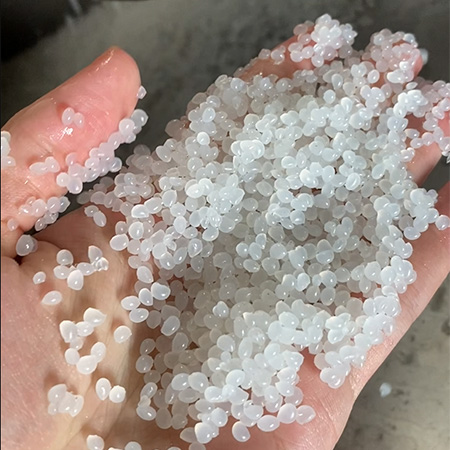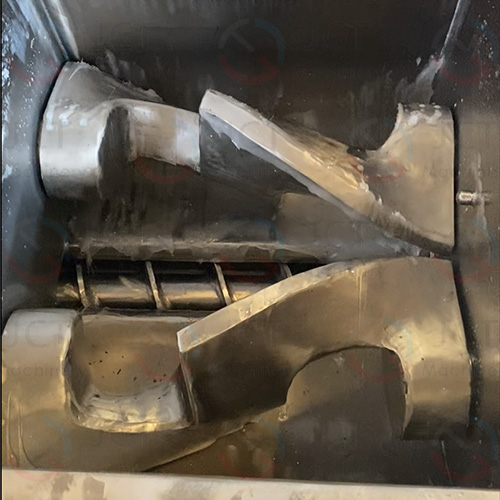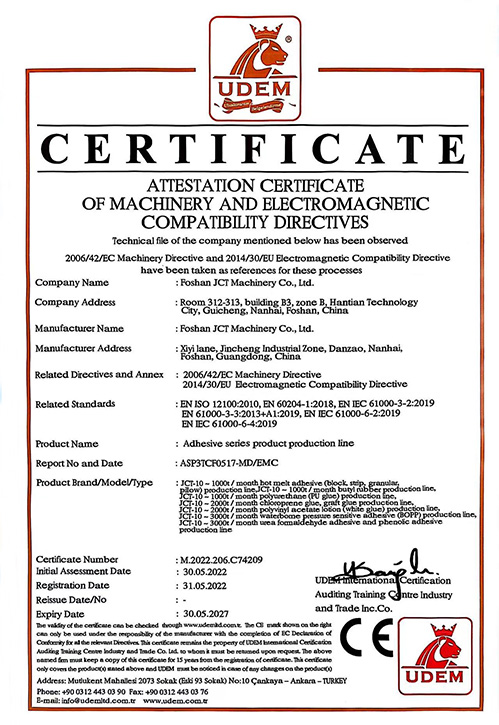Problem 1: Raw Material Agglomeration and Uneven Dispersion
Symptom: Powdered raw materials (such as EVA resin) clump due to moisture, or dust is generated during dosing, resulting in uneven subsequent melt mixing.
Cause:
- Raw material storage environment is humid.
- Improper dosing sequence, powder is trapped and unable to disperse.
- Insufficient premixing.
Solution:
- Raw material management: Raw materials (especially tackifying resins, waxes, etc.) should be sealed and stored in a cool, dry place.
- Dosing sequence: Follow the principle of "solids first, liquids second, less soluble first, more soluble". Typically, solid raw materials (such as base resins like EVA and SIS) are added first. After melting, tackifying resins, waxes, etc. are added in batches. Finally, antioxidants and fillers are added.
- Mechanical premixing: For large-scale production, a reactor can be used to premix solid raw materials to ensure uniform physical dispersion.
Problem 2: Product Discoloration and Charring
Symptoms: The colloid color darkens (brown or even black), has a burnt odor, and performance deteriorates.
Causes:
- Excessive temperature: Local or overall temperatures exceed the thermal decomposition temperature of the raw materials.
- Excessive heating time: The material remains in the reactor for too long.
- Ineffective agitation: Improperly designed or malfunctioning agitator leads to local overheating.
- Ineffective or missing antioxidant: Oxidative degradation of the material occurs.
Solutions:
- Precise temperature control: Calibrate the temperature sensor, use staged heating, and precise PID temperature control to ensure the temperature is within the process requirements.
- Optimize agitation: Ensure the agitator operates properly and select an agitator the generates high shear and good circulation (such as an anchor or screw combination).
- Shorten residence time: Optimize production flow to avoid prolonged retention of the material at high temperatures.
- Adding antioxidants: It is necessary to add appropriate amounts of highly effective antioxidants and ensure that they are evenly dispersed.

Problem 3: Scaling and Scrapping in Reactor
Symptom: A thick layer of charred adhesive accumulates on the reactor walls and impellers, affecting heat transfer efficiency and stirring.
Cause: A large temperature difference between the material and the metal wall, or strong material adhesion.
Solutions:
- Reactor wall coating/polishing: JCT's hot melt glue production line utilize stainless steel reactors with mirror polish or anti-stick coating (such as Teflon).
- Use a scraper: The impellers have scraping function that continuously removes material from the inner walls, promoting heat exchange.
- Regular cleaning: Develop a schedule for regularm high-temperature cleaning using a dedicated cleaning agent or "reactor cleaning compound".
Problem 4: Unstable Extrusion and Uneven Strip Size
Symptom: The extruded strips vary in thickness and are intermittent.
Causes:
- Melt pressure fluctuations: Unstable discharge from reactor or unstable screw pumping.
- Uneven temperature: Uneven die temperature leads to inconsistent melt viscosity.
- Bubbles: Air or vaporized water is trapped in the material.
Solutions:
- Stable feeding: Ensure uniform and stable discharge from reactor to the extruder. A metering pump or screw feeder can be used.
- Uniform die temperature: Check that the die heater is functioning properly and ensure consistent temperature across the entire die width.
- Vacuum degassing: Install a vacuum degasser in the extruder section to remove air and volatile components from the melt.
Problem 5: Adhesive Strips Sticking and Insufficient Cooling
Symptom: Hot melt glue strips stick together and deform in the cooling trough or conveyor belt.
Causes:
- Cooling water temperature is too high or flow rate is insufficient.
- The spacing between adhesive strips is too small.
- The adhesive strips contact the guide roller or conveyor belt before they are fully cured.
Solutions:
- Intensify cooling: Lower the cooling water temperature (usually chilled water), increase the water flow rate, and increase the cooling trough length.
- Adjust spacing: Adjust the die hole spacing and pull-off speed to ensure adequate spacing between adhesive strips.
- Optimize the path: Ensure the adhesive strips have sufficient immersion time and travel in the cooling trough, allowing them to fully cure after exiting the water before contacting the guide roller.
Problem 6: Tailing and Connected Pellets
Symptom: Pellets have tails or two or more particles are connected.
Causes:
- Cutter blades are not sharp or have inappropriate clearance: The hot melt glue strip cannot be cut cleanly.
- Hot melt glue strip temperature is too high: The rubber strip is too soft and easily deforms and sticks during cutting.
- The haul-off speed does not match the cutter speed.
Solutions:
- Cutter blade maintenance: Regularly inspect and polish or replace the cutter blade, and adjust the gap between the movable and fixed blades.
- Reducing hot melt glue strip temperature: Ensure that the glue strip has been fully cooled to below its glass transition temperature (Tg) before entering the pelletizer to maintain sufficient hardness.
- Speed synchronization: Accurately synchronize the haul-off speed and cutter speed to ensure consistent cut lengths per revolution.

Why Choose JCT's Hot Melt Glue Production Line Turnkey Project?
- Improve product consistency: Ensure zero batch-to-batch variability through stabilized equipment (melt pumps, servo systems) and intelligent control.
- Reduce overall costs: High heat transfer efficiency (scrapers) saves energy; high yield (reduced scrap) saves materials; automation reduces labor.
- Enhance production flexibility: Modular design and recipe management capabilities easily enable small-batch, high-variety production.
- Ensure operational safety and environmental protection: Closed systems and automated controls reduce human exposure to high-temperature materials and chemicals, and eliminate dust.
- Provide turnkey projects: We offer more than just equipment sales; we provide a comprehensive solution from plant planning, equipment installation, commissioning training, and after-sales maintenance.

 JCT
JCT  2025-10-14
2025-10-14



